So in our animation class today we discussed music and animation and I felt it best to sort out my thoughts on this blog since we are talking about sound. I don't know why but I generally have a great deal of disregard for muscials I don't know if it's the Disney effects of having watched so many animations as a kid and all those songs from them being played everywhere but I can't stand it.
But growing and certainly working in this industry and learning about the history of cinema I've come to appreciate it more. Musicals started way back with Fred Astaire and Ginger Rogers and Gene Kelly and so on they helped the American public suspend thier disbelieve and really immerse themselves in something delightful rather than indulge in post world wars tragedies and all the trouble of the cold war and other wars that followed. They soon died off and were not as popular and apparant as they used to be.
Interestingly enough they did appear back in the ninties in animation, and the question that was asked in class today is why did that happen. The reasons were that a lot of the producers and people working in the Disney animation studioes at the time really believed they could revive musicals through animation and the major factor was that they were all broadway producers and had that theater background to them and moved from that industury only because it was harder to make a living out of it and chose animation.
Until today those musicals in Aladin, or Lion King or any of those Disney classics still lives on and in this case they definitely bring back memories. They really pushed the genre at the time and the musical function in several ways, it really helped add to the story and conveyed the general idea and plot and even adds to the mood of the film.
Obviously that has died down a great deal and what was brought up during class was the idea of how muscials may not function so well in America but other parts of the worlds, and what's funny is that I asked an Indian producer why Bollywood continues to and remains through out their history creating the same types of films that are heavy with musicals and his response was that they worked as an escapesed tool. People watched those to cheer themselves up and forget about the depressing and harsh lives that they lived.
So it was interesting to think about the emotional aspects of music and how it certainly adds a great deal to the visual world of cinema regardless of the medium or setting.
Thursday, November 29, 2007
Happy Birthday Song
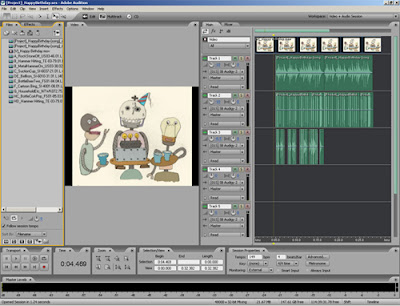 It is the first time I use Audition. Thanks for Jan's helping me how to make some sound effect that I want to do.
It is the first time I use Audition. Thanks for Jan's helping me how to make some sound effect that I want to do.As for my project, first I wanted to build the main melody (Happy Birthday song) with hitting sound. So I found sound from the library that might have some pitch. I heard those sound and arranged file name something like C-filename, D-filename, E-filename......and then when I edit the happy birthday song, I won't get trouble. When I want to put a sound Do, I could grab the correct file. I put some sound from hitting iron or metal hammer in Track 3 and tried to let them become the happy birthday song. Actually some work but some don't. So I put two simple happy birthday with real melody in the track. I think they can help audience to recognize it is a birthday song. I found these two birthday song form website. One plays in music box and the other is made by digital sound.
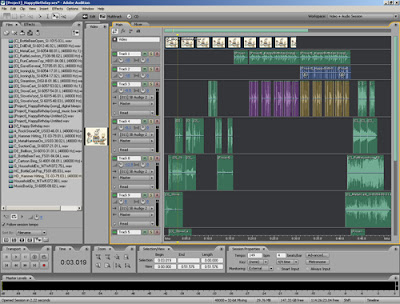 When I finish the main melody, I stared to deal with other environment sound. Those works are according to my picture- three robots holding a cake and drinks. In the beginning, I imagined they prepared things to celebrate. So there are sound I want them to feel like preparing somethings in a flurry. Then robot A starts singing happy birthday song but robot B stops it. Robot B plays the music box, and then three of them sing together. When the song finished, there are sound I want them to feel like cheerful.
When I finish the main melody, I stared to deal with other environment sound. Those works are according to my picture- three robots holding a cake and drinks. In the beginning, I imagined they prepared things to celebrate. So there are sound I want them to feel like preparing somethings in a flurry. Then robot A starts singing happy birthday song but robot B stops it. Robot B plays the music box, and then three of them sing together. When the song finished, there are sound I want them to feel like cheerful.Yesterday Jan suggest me put some ambiance sound in the background. I try to find some that can fit in this piece, however I don't think I find the great one. Finally I put an ambiance about household in the background but the volume is small.
I put the file that I mix down in my file of Sound and Consciousness Group already.
I think I done this piece . Then I will try some sound postcard about Taiwan but I didn't come up a good idea yet. So, keep working.
Wednesday, November 28, 2007
Site Design
I played around with John's website prototype and really liked the idea of using a radio as the GUI. I also agree with Jan's comment that the design should center more around sound than around visuals, and I'd like to help further develop this notion. I'll be posting some designs and possible navigation layouts that I think would be helpful to bringing everyone's work together.
Coagula
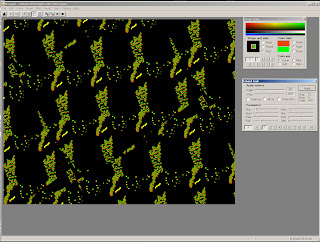
This is a screen grab from a interesting piece of software I discovered called "Coagula." This allows you to "draw" sounds. The types of sounds are somewhat limited because it creates digital scrambles of tones and pops and noise. However, used in the right way, I think the program could produce really amazing results. We had a visit from sound designer Dane Davis who said he used high-end programs like this while working on the 'Matrix Trilogy' and other films. In terms of science fiction, the program can really enhance the process of creating abstract sounds by giving you a way to intuitively create them through drawing. From reading Bill Whittington's book, 'Sound Design and Science Fiction,' I appreciated the careful attention given to the sound of the character R2-D2. This is a character that has no facial expressions and very limited movements, but through the development of a digital language by Burtt, is one of the funniest characters in the 'Star Wars' films. It would be interesting to develop more of a sound language using Coagula.
The Conversation Grows
I just wanted to respond to Malak's last three postings. Thanks for the feedback on my "Saving Private Ryan" post, it was interesting to read about your surprise at Spielberg's decision to suspend the score during the battle scenes. And I think you hit on something that I've been reading about in Bill Whittington's book, "Sound Design and Science Fiction." Directors, sound designers, and composers must re-think the function of sound for every project they work on. Bill Whittington discussed this in relation to many films like 'Star Wars, Alien, and Blade Runner.' He wrote that the first sound designers, Walter Murch and Ben Burtt, really understood the use of sound throughout film history, in addition to knowing genre conventions and even the inventory of some studios' sound libraries. With this knowledge, they were able to re-think the use of sound specific to each story. With this came the development of the craft and artistry known as sound design, which is a late addition to the film crew. Before, sound was passed between sound recordists, to sound editors, and finally to sound mixers. With the highly developed work done by Walter Murch and Ben Burtt, a new position was needed to describe sound artist who oversees the sound all the way through from recording to mixing. Ultimately, they must analyze how sound will function in a film in relation to the story, history, and genre conventions.
Malak, I appreciated your honesty regarding your fear of working with sound, but it seems that you're growing past your fears and I'm sure your films will be even better as a result. For your creative piece, I liked your description, but one thing stuck out which might help to develop it further. You said that sound can be used to create memories. This was interesting in terms of your project, because each of the three frames could represent a different memory. For example, with the shot of the mouse, you could add background layers to your soundtrack that could allude to a funny old computer game like "Carmen SanDiego." I definitely think you need to work with more layers in the piece and this will help you to achieve an experience.
Malak, I appreciated your honesty regarding your fear of working with sound, but it seems that you're growing past your fears and I'm sure your films will be even better as a result. For your creative piece, I liked your description, but one thing stuck out which might help to develop it further. You said that sound can be used to create memories. This was interesting in terms of your project, because each of the three frames could represent a different memory. For example, with the shot of the mouse, you could add background layers to your soundtrack that could allude to a funny old computer game like "Carmen SanDiego." I definitely think you need to work with more layers in the piece and this will help you to achieve an experience.
Tuesday, November 27, 2007
Sound and Image
For my project I was exploring the relationship between imagery and sound. How they both inform each other and our own associations with them. Different people can hear the same sound and respond differently, and even think differently of it. I was experimenting with the same sound and using it in conjunction with a different action. I want to convey how sound is this complex medium carrying a multitude of meaning. It can evoke emotions and memories. It works as a medium on its own and also along side or in contrast to imagery and so forth. What I used with this simple sound, and first I used it to convey the movement of the caterpillar across the tree branch, then I used that same sound to convey the movement of the brush and lastly the movement of the mouse across the pad.

Sound and Effects
I was just working on creating the track and sound effects for my production zero animation and I started realizing a lot of things.
I first started by adding this instrumental track to my piece and worked on editing it so that it fit with the emotional lows and highs of the piece. Before taking this seminar class and researching music I would have been absolutely fine with just turning in my piece that way. I created an animation with a beautiful track to accompany it. The problem is that I started to realize that it was lacking and I’ve come to appreciate sound and realize that it really does lend a great deal to any visual piece.
What I had initially was two components to my animation the obvious visuals and an obvious sound track and nothing in between. My animation actually reminded me of the older films made before the advent of sound. It was like watching a film and I could almost imagine someone with a piano accompanying it.
So I proceeded to add sound effects, which I honestly have a great deal of fear in doing. I have this paranoia that it will take away from the sound track. I also don’t know anything about technically editing sound which is probably why I’m so hesitant when it comes to this part of the filmmaking.
The surprising thing for me was that adding the sound effects actually helped the piece and the track was not lost at all and if anything adding that layer cushioned both the visuals and the sound track and I feel like it all blends together a lot well.
My first scene involves a pan down on this outdoors environment and a caterpillar crosses a tree branch and a girl pops up and looks at it. The sound track starts off with this soft playful piano melody and the visuals only. I then added ambient sound of birds chirping, wind, trees and leaves rustling which brought the environment alive and effects for the caterpillar as he crosses and he also came to life. The moment I added the effects I felt like the caterpillar really moved rather than just stimulating the visual sensory I was having a full experience.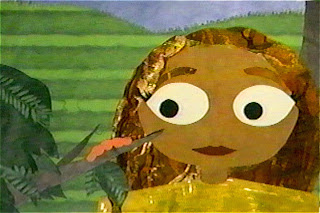 The second scene worked much in the same way. I added the sounds of her crying and the flapping of the butterfly’s wings and kept the environment sound playing in the back. The sound effects here helped add to the scene what it’s lacking. My animation is very limited and without the sound effect of her crying the audience would not be able to tell how she is feelings. So the sound effect here helped convey what I couldn’t visually.
The second scene worked much in the same way. I added the sounds of her crying and the flapping of the butterfly’s wings and kept the environment sound playing in the back. The sound effects here helped add to the scene what it’s lacking. My animation is very limited and without the sound effect of her crying the audience would not be able to tell how she is feelings. So the sound effect here helped convey what I couldn’t visually.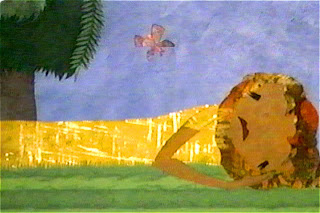 I’ve certainly developed much more of an appreciation and less of a fear towards the creation of sound for film.
I’ve certainly developed much more of an appreciation and less of a fear towards the creation of sound for film.
I first started by adding this instrumental track to my piece and worked on editing it so that it fit with the emotional lows and highs of the piece. Before taking this seminar class and researching music I would have been absolutely fine with just turning in my piece that way. I created an animation with a beautiful track to accompany it. The problem is that I started to realize that it was lacking and I’ve come to appreciate sound and realize that it really does lend a great deal to any visual piece.
What I had initially was two components to my animation the obvious visuals and an obvious sound track and nothing in between. My animation actually reminded me of the older films made before the advent of sound. It was like watching a film and I could almost imagine someone with a piano accompanying it.
So I proceeded to add sound effects, which I honestly have a great deal of fear in doing. I have this paranoia that it will take away from the sound track. I also don’t know anything about technically editing sound which is probably why I’m so hesitant when it comes to this part of the filmmaking.
The surprising thing for me was that adding the sound effects actually helped the piece and the track was not lost at all and if anything adding that layer cushioned both the visuals and the sound track and I feel like it all blends together a lot well.
My first scene involves a pan down on this outdoors environment and a caterpillar crosses a tree branch and a girl pops up and looks at it. The sound track starts off with this soft playful piano melody and the visuals only. I then added ambient sound of birds chirping, wind, trees and leaves rustling which brought the environment alive and effects for the caterpillar as he crosses and he also came to life. The moment I added the effects I felt like the caterpillar really moved rather than just stimulating the visual sensory I was having a full experience.
 The second scene worked much in the same way. I added the sounds of her crying and the flapping of the butterfly’s wings and kept the environment sound playing in the back. The sound effects here helped add to the scene what it’s lacking. My animation is very limited and without the sound effect of her crying the audience would not be able to tell how she is feelings. So the sound effect here helped convey what I couldn’t visually.
The second scene worked much in the same way. I added the sounds of her crying and the flapping of the butterfly’s wings and kept the environment sound playing in the back. The sound effects here helped add to the scene what it’s lacking. My animation is very limited and without the sound effect of her crying the audience would not be able to tell how she is feelings. So the sound effect here helped convey what I couldn’t visually. I’ve certainly developed much more of an appreciation and less of a fear towards the creation of sound for film.
I’ve certainly developed much more of an appreciation and less of a fear towards the creation of sound for film.Response to Sound creation in "Saving Private Ryan"
This was certainly very interesting. What I found remarkable was the comment about how the moment we add a soundtrack we start to feel we are watching a movie. I never thought about it but I actually completely agree. A battle scene with no music is definitely a lot rawer and has a touch of realism to it too. I find that when a track is added to a battle scene or something visually heavy like that we are taken out of it and respond more to the mood of the music, it becomes more of an emotional response, but a distant emotion, whereas watching a battle scene with no sound track that emphasizes all those visual nuances through sounds effects has a way of provoking more of a physical sensory response which is much better suited for a battle scene. We react physically which emphasizes the brutality of war and having a sound track we can start to react emotionally which is representative of the affects of war but not the actual act of it. It is real interesting how all these layers of sound can take and add to a film and the rest of the reading on how sound in the actual war itself was used strategically. What always fascinates me is how filmmakers and sound designers need to constantly relearn “listening” when it is such an integral part of our lives. I guess that’s what sound consciousness is all about.
Monday, November 26, 2007
Happy Birthday Song
I will use this picture and add sound effects to make it real. There will be a happy birthday song coming form music box as a background music and other sounds I list below will come together to become a happy birthday song.
Here are sounds or music I want to use.
-Happy Birthday Song (Music Box)
-knock/punch/bang iron things
-a sound when a lamp light on
-clock
-knock wood door
-Bottle Beer Open
-hammer hitting
..................................some sounds like that.
Here are sounds or music I want to use.
-Happy Birthday Song (Music Box)
-knock/punch/bang iron things
-a sound when a lamp light on
-clock
-knock wood door
-Bottle Beer Open
-hammer hitting
..................................some sounds like that.
Sunday, November 25, 2007
RE: Feedback
That sounds good, perhaps I'll incorporate another slider. Right now both knobs control the same functionalities of the slider.
As for the size of images, they should be smaller for the web: As of now the radio UI is 1024x768. The nested clips are smaller. Right now my project is 550x400. If you would like another standard please let me know.
Posted to hal in my section of the group folder.
As for the size of images, they should be smaller for the web: As of now the radio UI is 1024x768. The nested clips are smaller. Right now my project is 550x400. If you would like another standard please let me know.
Posted to hal in my section of the group folder.
Website Feedback
Awesome work John! Your carnival idea seems to be coming together. It's cool that you're challenging your self a little too by emphasizing subtlety and working within a narrow grayscale. I like that there are no images, you're only using your ears to navigate. I can't wait to try it out. The old time radio idea looks great, it's definitely taking shape. We just need to make sure to allocate space for the summaries of our guests and for a short video clip of each one's presentation. We'll talk about that more on Monday and the next time we meet. Very soon we need to decide who will summarize which guest. I will summarize the concepts presented by Bill Whittington, since I have been reading his book and looking for these ideas in other films, and I will put together a short piece that illustrates his work.
Fruits of Labor
After a long, long night's toil with flash I have a demo site I'm happy with. I'll be uploading it to HAL tomorrow, if you'd like to take a look.
I went with the idea of an antique radio system. I know we have to add some more things to the site, but this is a good starting place. Any feedback would be superb! There are still a few kinks, but my project has already been incorporated and is fully interactive.

I went with the idea of an antique radio system. I know we have to add some more things to the site, but this is a good starting place. Any feedback would be superb! There are still a few kinks, but my project has already been incorporated and is fully interactive.

Saturday, November 24, 2007
Grayscale Carnival Environment (In Progress)
Wow! Nice research Jan, that's quite a bit of inspiration. I know you all have been curious to see my machinations in flash and here is a shot of the work unfolding.
It has been a difficult task to work in a very, very narrow range of gray colors. The idea is to keep the user in the dark visually, but use a great deal of sound cues to simulate environment.
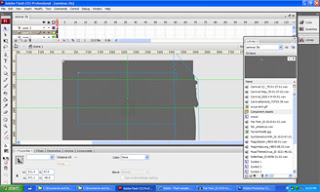
There will be another interactivity trigger that is being worked on as I report. The basic concept is that there will be small points of interactivity that must first be "discovered" in order for the user to begin to understand the environment. The reasons that larger ones were forgone is because if the "hit zones" become too large then the subtlety is lost.
It has been a difficult task to work in a very, very narrow range of gray colors. The idea is to keep the user in the dark visually, but use a great deal of sound cues to simulate environment.

There will be another interactivity trigger that is being worked on as I report. The basic concept is that there will be small points of interactivity that must first be "discovered" in order for the user to begin to understand the environment. The reasons that larger ones were forgone is because if the "hit zones" become too large then the subtlety is lost.
Sound and Music in 'Saving Private Ryan'
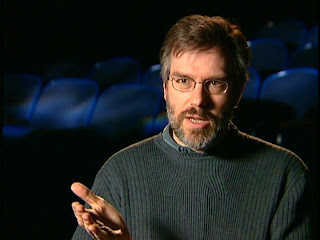
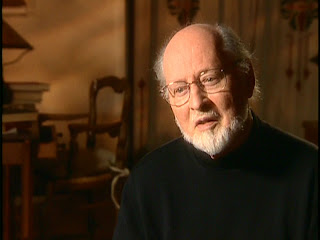
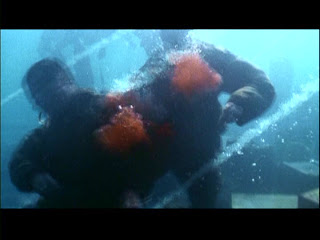
One of my classmates recommended that I watch a short piece interviewing John Williams and Gary Rydstrom about the making of the music and sound on the Saving Private Ryan DVD. In a short piece they both explained important elements central to the research of our group this semester.
John Williams has worked with Steven Spielberg on most of his films. When working with Spielberg, he prefers to see the film in its final stages rather than read the script ahead of time. For 'Ryan' Spielberg and Williams agreed not to use music during the battle scenes, but rather to keep them realistic. Williams wanted to focus on moments where the music would strike an emotional chord. For this, a choir was integral to the orchestra. Williams worked with the Boston Symphony Orchestra in the Boston Symphony Hall. As a side note, this particular music hall is one of the favorites of our guest, Tom Holman, who revers the acoustics in the Boston Symphony Hall as 'one of the great music halls in the world.' One thing I found interesting was in Williams' description of the Hymn to the Fallen which is the piece that closes the film. He said that it was a requiem for the people lost in the war. Often Williams composes for films by starting with the ending piece and then separating the ending and having threads of the ending running throughout the film. The threads of the music collect in the ending.
Gary Rydstrom has often been discussed in our research for creating the roars in Jurassic Park. However, I think 'Saving Private Ryan' is interesting for our research because he had to achieve a degree of realism so the film could be true to the memories of the people who were in it. He loved the opportunity to work on a war film that didn't have music in the battle scenes. Rydstrom asserts that anytime there is a score in a film, the audience feels like they're watching a movie. Without a score dominating the battle scenes, he was able to craft the scenes to be much more visceral. For example, the opening battle scene on Omaha Beach 'pulls you in and has you experience the battle in a very direct way.' Sound design guides the visceral experience. Spielberg told Rydstrom that he didn't want the sound to 'be Hollywood.' Rydstrom explains that this meant not using existing sound libraries, cliches, cheats, etc. This required the sound designer to do research by studying guns and weaponry and interviewing veterans to hear their experiences of the war and what it sounded like. He was surprised to learn how much of their memories were driven by the sounds of the battlefield. For example, the Germans listened for a particular 'ping' that came from ejecting an empty shell cartridge from an American gun. The Americans simulated these 'pings' to lure the Germans out from hiding. Through these 'revelatory' interviews, Rydstrom became passionate about achieving sound design that was true to their memories.
In the beginning of the film, in the Omaha Beach scene, Rydstrom wanted to recreate the experience of being shot at. For this scene he broke the scene into important elements. The most important elements were bullet impacts. For the pre-mix of the bullet impacts he had cue sheets stacks thick as phonebooks.
The Omaha Beach scene contains moments in the water where the camera bobs above and under water. Rydstrom took the opportunity to create contrasting perspectives above and underwater. Above water the battle rages and Rydstrom describes it as ' chaos and cacophony.' Underwater the cacophony goes away and the water becomes safe, like a cocoon. By placing these two perspectives in contrast, Rydstrom is able to unsettle the viewer when bullets pierce into the cocoon and kill the soldiers. For the sound of bullets piercing underwater, Rydstrom demonstrates using an un-horrific sound for horrific effect. He used the sound of a fly-fishing line being ripped out of the water, which he had saved from A River Runs Through It.
In terms of Sound and Consciousness, Rydstrom discusses scenes where Tom Hanks' character becomes shell-shocked. In these scenes, amidst the battle, the sound is taken out of the battle into Tom Hanks mind, creating an abstract expression and a window into the traumatic state of mind. According to Rydstrom, 'Taking the sound out of the battle became an interesting device to get inside someone's head.' Rydstrom had to imagine what it would be like to hear the sound of yourself. He remembered the experience of listening to a sea shell. "What you hear is an echo of the world around you, roaring in your head." To simulate this, Rydstrom recorded sounds of the ocean, then played them through speakers and re-recorded them by placing the microphone inside a long tube. This made 'a resonant shell sound.' Furthermore, Spielberg had the brilliant idea to conclude the interior experience with a high-pitched tea whistle that zapped the viewer back into reality. This proved to be really effective. In the final battle, the sound design returns to the effects of shell shock for Tom Hanks' character. Rydstrom manipulates the perspective in order to let the viewer see through this character's eyes. This effect allows us to identify with this character even more.
In the final battle, German tanks approach the few American troops still alive in the French town. During the night, they hear quiet, distant rumbling, like distant thunderstorms, from battles being fought miles away. Again, Rydstrom had to do research to achieve the effect he wanted. He found real recordings of World War Two battles and discovered they had the 'storm' quality to them. When he added the final layer of this distant rumble, he felt he had achieved a sense of reality and depth with the intricacy of the war in close perspective and also the sounds of the war on the horizon. This consciousness of sound delivers a profound sense of the scale of this war. Furthermore, in the final battle, the sound design changed to build on the tension the soldiers felt as the tanks approached, rather than the plunging in we experience of the Omaha Beach scene. For some time as they wait, we only hear the tanks approach. Spielberg referenced the film Zulu and required Rydstrom to study a particular scene where the Zulu warriors encroach on a British fort. Spielberg didn't want a copy of that sound, but he wanted the sound design to capture the feel and the essence of it. When the tanks arrive, Rydstrom created the sound of the tank wheels, squeaking and churning all from scratch. He played a selection of random sounds on 1/4 in. tape and reversed and slowed the sounds to create wild echoes simulating the clanging, rumbling tank bodies.
Studying Gary Rydstrom's work in 'Saving Private Ryan' directly to relates to Bill Whittington's research on sound design. All of the methods and philosophies of sound designers like Walter Murch are present in Gary Rydstrom's research, techniques, and thematic attention to detail. John Williams music for the film is also a great compliment to the presentation given by our guest Ken Hall. The music is selectively used to generate elegant moments of reverence and retrospection.
Friday, November 23, 2007
Adobe Soundbooth
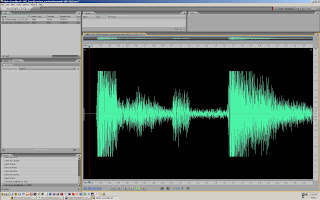 Adobe Soundbooth for CS3 is a new sound-creation, composing, and sound designing package. At first I expected a direct replacement of Adobe Audition, which I understand is being modified. Soundbooth allows you to manipulate individual sounds by the ability to push the sound through a series of different effects. From my current research, I see the program as Photoshop for sound. I tried a few tests with a sample of sound from the construction site of the new Lucas Building here at USC. This is a great tool for a sound designer, because one can put a lot of attention into single sounds to stylistically treat them for a piece. As of now, my pipeline will take sounds recorded in the field, then I will manipulate them in Soundbooth, and finally I will layer, edit, and mix them together in Audition. I will follow the same path with pieces from Loopoly to create my own version of a "Sound Postcard."
Adobe Soundbooth for CS3 is a new sound-creation, composing, and sound designing package. At first I expected a direct replacement of Adobe Audition, which I understand is being modified. Soundbooth allows you to manipulate individual sounds by the ability to push the sound through a series of different effects. From my current research, I see the program as Photoshop for sound. I tried a few tests with a sample of sound from the construction site of the new Lucas Building here at USC. This is a great tool for a sound designer, because one can put a lot of attention into single sounds to stylistically treat them for a piece. As of now, my pipeline will take sounds recorded in the field, then I will manipulate them in Soundbooth, and finally I will layer, edit, and mix them together in Audition. I will follow the same path with pieces from Loopoly to create my own version of a "Sound Postcard."
Image and Sound Relationships
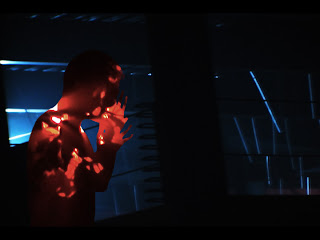
In Bill Whittington's Book, Sound Design & Science Fiction, he thoroughly describes the role of a sound designer. For my final project, I would like to further develop these concepts into a short project. Sound designers like Walter Murch and Ben Burtt rejected the use of sound libraries. They created a pallette of effects for each film. In his work on THX 1138, he recorded sounds on construction sites, airports, zoos, and more to describe the futuristic and psychological world of THX.
In the Contemporary Topics class, Prof. Kathy Smith had students create abstract imagery, combining it with originally designed "Sound Postcards." Many of the 'postcards' featured a musical element to the sound design like a classmate singing. This relates to one of Murch's philosophies on Sound Design in that the sound designer is composing a piece, highly aware of the musical characteristics of each sound. High and low frequencies can play off of each other and quiet and loud contrast is the most important relationship in creating tension.
Wednesday, November 21, 2007
Interactive Sound and Sound Environments
Brian and John both presented some interesting illustrations of their ideas for our Sound and Consciousness website. It will be great to include a project like Brian's where a user can experience sound in an interactive way. I also really liked the peak I saw of Brian's Contemporary Topics project yesterday. Brian, you could create a compelling sound environment with that too. But, you definitely are on your way with the interactive concept that you have.
John's creation of a carnival environment will be interesting, especially if he develops subjectivity into the experience of a carnival. For a child, a carnival can be a wonderful, happy place, but for a deranged or paranoid person, the environment can quickly become a nightmare. Have you decided any particular perspective for the environment?
John's creation of a carnival environment will be interesting, especially if he develops subjectivity into the experience of a carnival. For a child, a carnival can be a wonderful, happy place, but for a deranged or paranoid person, the environment can quickly become a nightmare. Have you decided any particular perspective for the environment?
Saturday, November 17, 2007
"Kuleshov" project
I'll be creating an interactive grid that allows the user to play a sound along with an image. Each image will be relatively neutral in terms of its content, and each sound will play off a different mood. Here are the sounds, with their tones in parantheses:
Hard Effects
-car screeching (intense)
-glass breaking (intense)
-thunder (intense)
-clock ticking (neutral)
Ambience
-birds chirping (peaceful)
-wind blowing (neutral)
-city streets (neutral)
-underwater (neutral)
Dialogue
-wallah (neutral)
-woman's scream (intense)
-baby crying (intense)
Here are the images I'll be using:
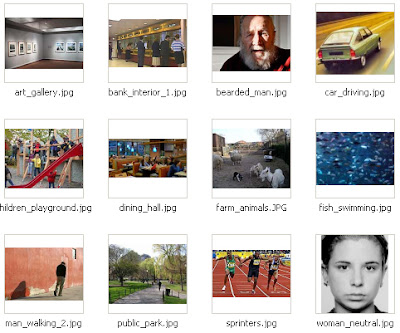
-Brian
Hard Effects
-car screeching (intense)
-glass breaking (intense)
-thunder (intense)
-clock ticking (neutral)
Ambience
-birds chirping (peaceful)
-wind blowing (neutral)
-city streets (neutral)
-underwater (neutral)
Dialogue
-wallah (neutral)
-woman's scream (intense)
-baby crying (intense)
Here are the images I'll be using:

-Brian
Friday, November 16, 2007
Sound As Environment
My project will involve the creation of an environment via sound. The Carnival/Circus environment will be illustrated through simple interactivity (in Flash) and the layering of sounds found on Netmix.
I found a bunch of interesting materials. The barkers (the fellows who always yell "Red Hots! Get yer Red Hots!" will add another dimension to the piece. The visual elements will be limited to a very tight grayscale range. This will necessitate the usage of sound as the dominant element. The user will then have to determine the environment.
Sounds:
Calliope (entrance to the big top)
Barkers
Crowd Cheering
Game noises
Some game noises
I found a bunch of interesting materials. The barkers (the fellows who always yell "Red Hots! Get yer Red Hots!" will add another dimension to the piece. The visual elements will be limited to a very tight grayscale range. This will necessitate the usage of sound as the dominant element. The user will then have to determine the environment.
Sounds:
Calliope (entrance to the big top)
Barkers
Crowd Cheering
Game noises
Some game noises
Wednesday, November 14, 2007
Adobe Audition
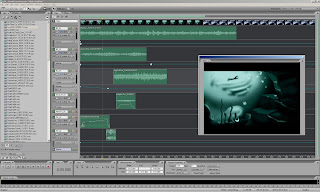
Here is a screen-grab from my current work. I am designing a subjective underwater environment. Thinking of the layering techniques used in science fiction sound design, I am trying to process music from loopology to create certain sounds. For example, I found an ambient, albeit electronic choir tone. By stripping it down using the Scientific Filters, I was able to create a thin cue that adds mood to the basic underwater ambience that I took from our sound library. More to come...
Leit Motif
As Bill Whittington points out in his book, the use of leit motifs in film scores is nothing new. In fact, attaching a particular melody to a character or event was central to classic Hollywood narrative filmmaking. However, for a student of sound, it is exciting to think of a collection of sounds in terms of leit motif. If a certain character always emitted these sounds, you could watch the film with your eyes closed and you would know that character is in the scene. I think the important part is to make your sound effects characteristic through recording, layering, or processing so that it's unique to the film. For example, the water that falls through the ship in "Alien" will forever remind people of the tension in that scene, without even seeing the film. I am interested in refining sound effects to a degree that they become stylized according to the world I am creating.
Tuesday, November 13, 2007
Pearl Diver Sound Idea List
From our Netmix Library:
BG/Ambience:
Underwater ocean ambience
Muffled Bubbling
Low-Freq throbbing
Digeridoo
Hard FX
Splashes
Exhaling
Man straining to hold his breath
knife into can
can opener
suction releasing
rocks tumbling
Music/MX, from Adobe Loopology
Drum/Bell Jingles
Gong - pitch-shifted high
BG/Ambience:
Underwater ocean ambience
Muffled Bubbling
Low-Freq throbbing
Digeridoo
Hard FX
Splashes
Exhaling
Man straining to hold his breath
knife into can
can opener
suction releasing
rocks tumbling
Music/MX, from Adobe Loopology
Drum/Bell Jingles
Gong - pitch-shifted high
Monday, November 12, 2007
Pearl Diver
Wednesday, November 7, 2007
Tuesday, November 6, 2007
Dream Landscapes
Subscribe to:
Posts (Atom)




